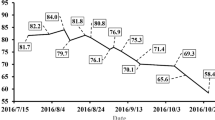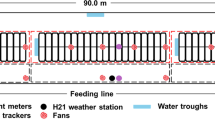Abstract
Thermography has grown in use in recent years. It is a valuable tool for measuring animal heat tolerance under heat stress conditions since it is a non-invasive, safe and practical methodology. Physiological variables such as respiration rate and eye temperature, and environmental variables such as air temperature and wet bulb temperature were analysed in animals from nine cattle breeds (Angus, Braford, Brangus, Canchim, Charolais, Hereford, Nelore, Simmental and Santa Gertrudis) and one bubaline (Mediterranean) at Rio Grande do Sul, Brazil. Positive correlations were observed between air temperature and respiration rate and eye temperature. Furthermore, the breed strongly influenced the eye temperature and respiration rate of the animals. Eye temperature showed strong correlation with air temperature and wet bulb temperature. Simmental and Nelore animals presented higher eye temperature values. Simmental presented alteration in respiratory rate before the other breeds and Nelore was the last breed to present this alteration. The inflection points in the broken line analysis indicated the environmental temperature limits at which breeds begin to change their respiration to compensate for environmental variation. The use of thermography has proven to be a technique with possible application to evaluate the temperature of animals. Logistic regression analysis allows us to observe how each breed behaves with the temperature change. Using respiration rates and eye temperatures it was possible to identify physiological limits for comfort in different breeds of bovine. In the future it would be interesting to conduct additional studies using other physiological variables and also other indices of climatic conditions.




Similar content being viewed by others
Data availability
The datasets generated during and/or analyzed during the current study are not publicly available because they are data that were collected manually during the experiment and stored by the researchers in their personal files but are available from the corresponding author upon reasonable request.
References
Anzures-Olvera, F., Véliz, F.G., de Santiago, A., García, J.E., Mellado, J., Macías-Cruz, U., Avendaño-Reyes, L., Mellado, M., 2019. The impact of hair coat color on physiological variables, reproductive performance and milk yield of Holstein cows in a hot environment. J. Therm. Biol. 81, 82–88. https://doi.org/10.1016/j.jtherbio.2019.02.020
Arnfield, A. J., 2023. “Köppen climate classification” published in Encyclopedia Britannica. The link to access it is: https://www.britannica.com/science/Koppen-climateclassification. Accessed May 15 2023.
Associação Brasileira dos Criadores das Raças Simental e Simbrasil, n.d. Conheças a Raça Simental [WWW Document]. URL http://simentalsimbrasil.org.br/raca-simental/ (accessed 5.2.22).
Bohmanova, J., Misztal, I., Cole, J.B., 2007. Temperature-humidity indices as indicators of milk production losses due to heat stress. J. Dairy Sci. 90, 1947–1956. https://doi.org/10.3168/jds.2006-513
Brandt, P., Bjerg, B., Pedersen, P., Sørensen, K.B., Rong, L., Huang, T., Zhang, G., 2022. The effect of air temperature, velocity and humidity on respiration rate and rectal temperature as an expression of heat stress in gestating sows. J. Therm. Biol. 104. https://doi.org/10.1016/j.jtherbio.2021.103142
Cardoso, C.C., Peripolli, V., Amador, S.A., Brandão, E.G., Esteves, G.I.F., Sousa, C.M.Z., França, M.F.M.S., Gonçalves, F.G., Barbosa, F.A., Montalvão, T.C., Martins, C.F., Neto, A.M.F., McManus, C., 2015. Physiological and thermographic response to heat stress in zebu cattle. Livest. Sci. 182, 83–92. https://doi.org/10.1016/j.livsci.2015.10.022
Church, J.S., Hegadoren, P.R., Paetkau, M.J., Miller, C.C., Regev-Shoshani, G., Schaefer, A.L., Schwartzkopf-Genswein, K.S., 2014. Influence of environmental factors on infrared eye temperature measurements in cattle. Res. Vet. Sci. 96, 220–226. https://doi.org/10.1016/j.rvsc.2013.11.006
Daltro, D. dos S., Fischer, V., Alfonzo, E.P.M., Dalcin, V.C., Stumpf, M.T., Kolling, G.J., da Silva, M.V.G.B., McManus, C., 2017. Infrared thermography as a method for evaluating the heat tolerance in dairy cows. Rev. Bras. Zootec. 46, 374–383. https://doi.org/10.1590/S1806-92902017000500002
Ferraz, J.B.S., Felício, P.E. de, 2010. Production systems - An example from Brazil. Meat Sci. 84, 238–243. https://doi.org/10.1016/j.meatsci.2009.06.006
Habibu, B., Yaqub, L.S., Dzenda, T., Kawu, M.U., 2019. Sensitivity, Impact and Consequences of Changes in Respiratory Rate During Thermoregulation in Livestock – A Review. Ann. Anim. Sci. 19, 291–304. https://doi.org/10.2478/aoas-2019-0002
Hoffmann, G., Schmidt, M., Ammon, C., Rose-Meierhöfer, S., Burfeind, O., Heuwieser, W., Berg, W., 2013. Monitoring the body temperature of cows and calves using video recordings from an infrared thermography camera. Vet. Res. Commun. 37, 91–99. https://doi.org/10.1007/s11259-012-9549-3
Idris, M., Uddin, J., Sullivan, M., McNeill, D.M., Phillips, C.J.C., 2021. Non-invasive physiological indicators of heat stress in cattle. Animals 11, 1–16. https://doi.org/10.3390/ani11010071
McManus, C., Paludo, G., Louvandini, H., García, J., Egito, A., Mariante, A., 2005. Heat tolerance in naturalised cattle in Brazil: physical factors. Arch. Zootec. 54, 453–458.
McManus, Concepta, Paludo, G.R., Louvandini, H., Gugel, R., Sasaki, L.C.B., Paiva, S.R., 2009. Heat tolerance in Brazilian sheep: Physiological and blood parameters. Trop. Anim. Health Prod. 41, 95–101. https://doi.org/10.1007/s11250-008-9162-1
McManus, C., Prescott, E., Paludo, G.R., Bianchini, E., Louvandini, H., Mariante, A.S., 2009. Heat tolerance in naturalized Brazilian cattle breeds. Livest. Sci. 120, 256–264. https://doi.org/10.1016/j.livsci.2008.07.014
McManus, C., Castanheira, M., Paiva, S.R., Louvandini, H., Fioravanti, M.C.S., Paludo, G.R., Bianchini, E., Corrêa, P.S., 2011. Use of multivariate analyses for determining heat tolerance in Brazilian cattle. Trop. Anim. Health Prod. 43, 623–630. https://doi.org/10.1007/s11250-010-9742-8
McManus, C., Dallago, B.S.L., Lehugeur, C., Ribeiro, L.A., Hermuche, P., Guimarães, R.F., Carvalho Júnior, O.A. de, Paiva, S.R., 2016a. Patterns of heat tolerance in different sheep breeds in Brazil. Small Rumin. Res. 144, 290–299. https://doi.org/10.1016/j.smallrumres.2016.10.004
McManus, C., Tanure, C.B., Peripolli, V., Seixas, L., Fischer, V., Gabbi, A.M., Menegassi, S.R.O., Stumpf, M.T., Kolling, G.J., Dias, E., Costa, J.B.G., 2016b. Infrared thermography in animal production: An overview. Comput. Electron. Agric. 123, 10–16. https://doi.org/10.1016/j.compag.2016.01.027
McManus, Concepta M., Faria, D.A., Lucci, C.M., Louvandini, H., Pereira, S.A., Paiva, S.R., 2020. Heat stress effects on sheep: Are hair sheep more heat resistant? Theriogenology 155, 157–167. https://doi.org/10.1016/j.theriogenology.2020.05.047
McManus, C., Bianchini, E., Paim, T. do P., De Lima, F.G., Neto, J.B., Castanheira, M., Ferreira Esteves, G.I., Cardoso, C.C., Dalcin, V.C., 2015. Infrared thermography to evaluate heat tolerance in different genetic groups of lambs. Sensors (Switzerland) 15, 17258–17273. https://doi.org/10.3390/s150717258
McManus, C. M., Faria, D.A., de Bem, A., Maranhão, A.Q., Paiva, S.R., 2020a. Physiology and genetics of heat stress in cattle. CAB Rev. Perspect. Agric. Vet. Sci. Nutr. Nat. Resour. 15. https://doi.org/10.1079/PAVSNNR2020015018
McManus, C., Hermuche, P.M., Paiva, S.R., Guimarães, R.F., Carvalho Junior, O.A., Blackburn, H.D., 2021. Gene bank collection strategies based upon geographic and environmental indicators for beef breeds in the United States of America. Livest. Sci. 254. https://doi.org/10.1016/j.livsci.2021.104766
Naveena, B.M., Kiran, M., 2014. Buffalo meat quality, composition, and processing characteristics: Contribution to the global economy and nutritional security. Anim. Front. 4, 18–24. https://doi.org/10.2527/af.2014-0029
NRC, 1971. A Guide to Environmental Research on Animals. Natil. Acad. Sci. 8, 75–75. https://doi.org/10.1007/bf00932856
Omran, F., 2021. Buffaloes and climatic change: mitigation and adaptation. Egypt. J. Agric. Res. 0, 0–0. https://doi.org/10.21608/ejar.2021.58892.1074
Radostits, O.M., Gay, C.C., Blood, D.C., Hinchcliff, K.W., 1983. Veterinary Medicine - A textbook of the Diseases of Cattle, Sheep, Goats and Horses, Veterinary Medicine. Saunders Ltd. https://doi.org/10.1016/b978-0-7020-5246-0.00032-2
Rejeb, M., Sadraoui, R., Najar, T., M’rad, M. Ben, 2016. A Complex Interrelationship between Rectal Temperature and Dairy Cows’ Performance under Heat Stress Conditions. Open J. Anim. Sci. 06, 24–30. https://doi.org/10.4236/ojas.2016.61004
Rubio Lozano, M.S., Ngapo, T.M., Huerta-Leidenz, N., 2021. Tropical beef: Is there an axiomatic basis to define the concept? Foods 10, 1–28. https://doi.org/10.3390/foods10051025
Santana, M.L., Pereira, R.J., Bignardi, A.B., Ayres, D.R., Menezes, G.R.O., Silva, L.O.C., Leroy, G., Machado, C.H.C., Josahkian, L.A., Albuquerque, L.G., 2016. Structure and genetic diversity of Brazilian Zebu cattle breeds assessed by pedigree analysis. Livest. Sci. 187, 6–15. https://doi.org/10.1016/j.livsci.2016.02.002
Silva, R.G. da, 2000. Introdução à bioclimatologia animal. Editora Nobel, São Paulo.
Stumpf, M.T., McManus, C.M., Daltro, D.S., Alfonzo, E.P.M., Dalcin, V., Kolling, G.J., Vieira, R.A., Louvandini, H., Fischer, V., da Silva, M.V.G.B., 2021. Different methods of assessing udder temperature through thermography and their relation with rectal temperature. Trop. Anim. Health Prod. 53. https://doi.org/10.1007/s11250-020-02435-y
Valdez, A.M.R., Loera, J.J.P., Estrada, J.D.U., Angulo, A.E., Pérez, B.I.C., Rincón, F.G.R., 2022. Panting frequency and score in beef cattle in intensive finishing during summer in the dry tropics. Rev. Mex. Ciencias Pecu. 13, 559–572. https://doi.org/10.22319/rmcp.v13i2.5977
Vieira, R., Louvandini, H., Barcellos, J., Martins, C.F., McManus, C., 2022. Path and logistic analysis for heat tolerance in adapted breeds of cattle in Brazil. Livest. Sci. 258, 104888. https://doi.org/10.1016/j.livsci.2022.104888
Vishwakarma, G.K., Paul, C., Hadi, A.S., Elsawah, A.M., 2023. An automated robust algorithm for clustering multivariate data. J. Comput. Appl. Math. 429, 115219. https://doi.org/10.1016/j.cam.2023.115219
Wanapat, M., Kang, S., 2013. World buffalo production: Challenges in meat and milk production, and mitigation of methane emission. Buffalo Bull. 32, 1–21.
Yadav, B., Yadav, P., Kumar, M., Vasvani, S., Anand, M., Kumar, A., Swain, D.K., Yadav, S., Madan, A.K., 2022. Effect of Heat Stress on Rumen Microbial Diversity and Fermentation Pattern in Buffalo. Adv. Gut Microbiome Res. 2022, 1–14. https://doi.org/10.1155/2022/1248398
Yan, G., Liu, K., Hao, Z., Shi, Z., Li, H., 2021. The effects of cow-related factors on rectal temperature, respiration rate, and temperature-humidity index thresholds for lactating cows exposed to heat stress. J. Therm. Biol. 100, 103041. https://doi.org/10.1016/j.jtherbio.2021.103041
Acknowledgements
To CAPES for scholarships.
Author information
Authors and Affiliations
Contributions
All authors contributed to the study conception and design.
Renata A. Vieira: Formal analysis, Investigation, Writing – original draft, Writing – review & editing, Visualization.
Eduardo A. Dias: Methodology, Investigation, Writing – review & editing, Validation, Visualization.
Marcelo T. Stumpf: Methodology, Investigation, Writing – review & editing, Validation, Visualization.
Gabriel R. Pereira: Methodology, Investigation, Writing – review & editing, Validation, Visualization.
Julio O. J. Barcellos: Conceptualization, Methodology, Investigation, Writing – review & editing.
Giovani J. Kolling: Methodology, Investigation, Writing – review & editing, Validation, Visualization.
Concepta McManus: Conceptualization, Methodology, Formal analysis, Investigation, Writing – original draft, Writing – review & editing, Visualization, Supervision.
Corresponding author
Ethics declarations
Ethics approval
The Ethics Committee approved the present study for Animal Use of the Federal University of Rio Grande do Sul, number 22773.
Competing interests
The authors have no relevant financial or non-financial interests to disclose.
Additional information
Publisher's note
Springer Nature remains neutral with regard to jurisdictional claims in published maps and institutional affiliations.
Rights and permissions
Springer Nature or its licensor (e.g. a society or other partner) holds exclusive rights to this article under a publishing agreement with the author(s) or other rightsholder(s); author self-archiving of the accepted manuscript version of this article is solely governed by the terms of such publishing agreement and applicable law.
About this article
Cite this article
Vieira, R.A., Dias, E.A., Stumpf, M.T. et al. Use of thermography and physiological rate to assess heat tolerance in cattle breeds. Trop Anim Health Prod 55, 223 (2023). https://doi.org/10.1007/s11250-023-03613-4
Received:
Accepted:
Published:
DOI: https://doi.org/10.1007/s11250-023-03613-4




